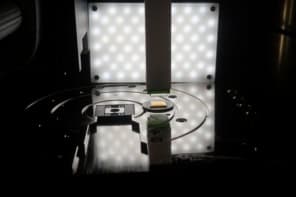
A new record for long-range, weak interactions between solitons has been reported by researchers in New Zealand. Two solitons in the same system were seen to affect each other through ultrasound waves as they travelled round a loop of fibre-optic cable. The consequences of this interaction, which caused the trailing soliton to be attracted or repelled by its leading partner, were only visible when the pulses had travelled more then one astronomical unit (AU).
Astronomical speeds
The researchers observed this effect in a 100-m-long loop of optical fibre. Two temporal-cavity solitons – particle-like pulses of light that retain their shape as they propagate – were sent round the loop, separated initially by one billionth of a second. By measuring the pulses with a photodetector and an oscilloscope, the team observed, in real time, the solitons slowly repelling or attracting each other. Before the effect became large enough to become noticeable the pulses had to travel a considerable length, namely 150 million kilometres, which is equivalent to the distance between the Earth and the Sun; this equates to a change in the gap between the looping solitons of one billionth of a billionth of a second for each trip round the optical circuit.
“To our knowledge, this is the weakest interaction ever observed between solitons,” says lead researcher Miro Erkintalo of the University of Auckland. He tells physicsworld.com that “the sheer fact that such a weak interaction can be observed in a noisy laboratory environment is simply spectacular”.
Along the fibre
As it progresses along the optical loop, the electric field of the first pulse deforms the fibre through which it travels, in a process known as electrostriction. This creates a small ultrasound wave in the soliton’s wake, the passage of which temporarily shifts the density of the fibre, changing its refractive index. When the second soliton passes through the sound wave, it therefore speeds up or slows compared with the first pulse. “The interaction is mediated by sound waves created by the solitons,” Erkintalo says, “so you could really say that the two are talking to each other!”
While short-range interactions were expected from previous theoretical studies, the discovery of these long-range interactions was a complete surprise for the researchers – who were originally looking at possible telecommunications applications. “The sexy thing about temporal-cavity solitons is that they can be used as bits in ultrafast all-optical memories,” says Erkintalo. Such memory systems have great potential to be faster and more energy efficient than current alternatives. The principle, however, has been difficult to realize.
Undesirable interactions?
The team set up the experiment to test whether bits of data could be preserved as long-lasting, discrete pulses of light, but instead the researchers observed the pulses influencing each other. “Initially, we desperately wanted to get rid of the effect because it was interfering with what we originally planned to do!” exclaims Erkintalo. In such a memory stream, interaction between optical bits would be undesirable because it would mess up the stored data.
The researchers discovered that the same long-range, sound-based interactions had been reported in previous studies. In this new case, however, the interactions were three to five orders of magnitude weaker than those previously reported, as well as having taken place over a much greater soliton separation – making this finding a significant record breaker.
“The work is a remarkable illustration of an extremely weak interaction between solitons,” says Andrey Gorbach, a physicist at the University of Bath who was not involved in this study. “In order to detect such interactions experimentally, the solitons had to cover a distance some billion times larger than [their] effective size. The fact that the solitons remain coherent over such astonishing distances emphasizes the extreme robustness of these objects.”
While the team is delighted to have found these unexpected interactions, the researchers are now working on trying to get rid of them. If they succeed, then this could pave the way to using solitons for the telecommunications purposes that the team originally set out to investigate. “We believe we can do this by modulating the beam holding the solitons,” comments Erkintalo. “[This] is what we are currently working on.”
The research is published in Nature Photonics.



